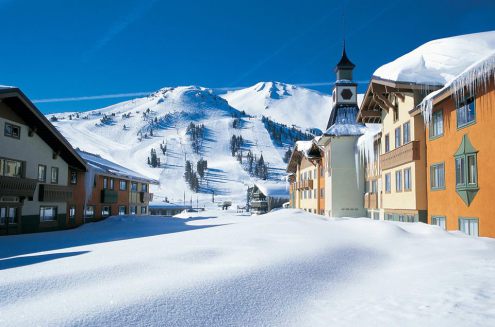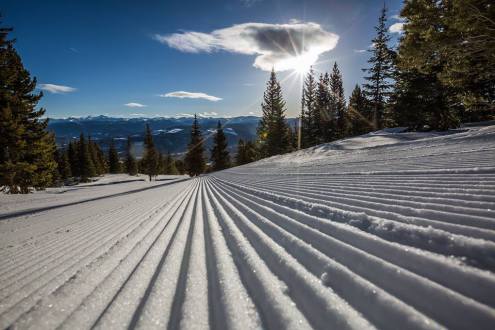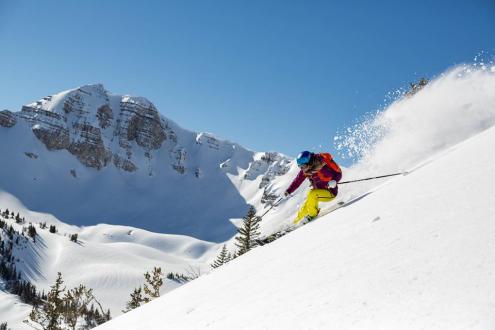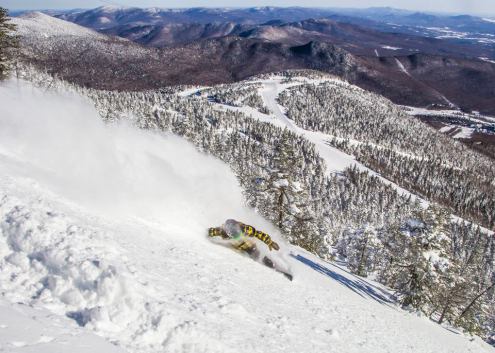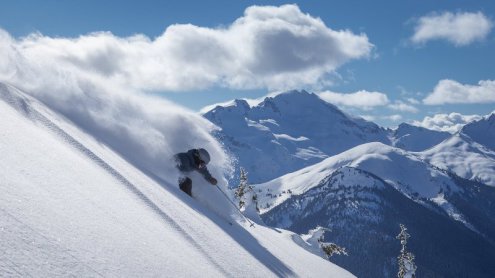Who got the most snow in North America in 2016-17?
Guest feature by Tony Crocker, 30 August 2017
2016-17 was a top five snowfall season in North America's ski areas, at 119% of normal, far behind only 2010-11.
Qualitatively it probably ranks fifth, also trailing 1981-82, 1996-97 and 2007-08, due to extreme concentration of snowfall midwinter, and most regions seeing some prolonged dry spells during other months. December was a strong enough month that most areas enjoyed a good holiday season.
The south-west flow during the big atmospheric river storms resulted in some unusual relationships within regions.
California
Snowfall in California through the 2016-17 Christmas/New Year holiday season was average at higher altitude areas, but lower areas had excessive rain.
Three atmospheric river storms slammed California in January 2017, producing a record 5-7m of snow, followed by two more in February totalling 3-5m. Snowfall was about half of average in March but above average in April.
The overall Sierra season was 155% of normal, comparable to other huge years in 1983, 1995 and 2011. Season snowfall records were set at Northstar (14.9m, 191%) and Heavenly’s upper site (16.2m, 169%). Mt. Rose recorded 15m (174%) at its official site near the base but had about 20m up high.
The highest snowfall at a long term measuring site was 18.4m (161%) at Sugar Bowl. With the massive snowpack, Squaw Valley (18.3m, 158% at its upper site) will be open weekends into July, and Mammoth (15.7m, 174%) daily into August.
Utah
Utah had an average early season but was hit by the atmospheric river storms coming from California in January (4m+) and February (3m+) 2017. March snowfall was below average and April snowfall above average, with the season overall at 120% of normal.
Alta had 15.1m (114% of normal) but other Utah areas fared relatively better. Park City had record snowfall of 10.8 meters (147%), Snowbasin had 11.5m (144%) and Brighton led the state with 16.6m (135%). Snowbird (14.3 m, 115%) is open weekends in June 2017.
Colorado
Colorado was bone dry for the first half of November 2017 but 2m of December snow more than made up the deficit by Christmas. The big January storms still had enough punch left to snow 2.5m over most Colorado resorts, with up to 4m in a few favoured locations.
Front Range resorts had about half normal snow in February and March, while the Southwest areas caught more of the February storms coming from the West Coast. The Front Range areas had more snow in April/May, allowing A-Basin (8.9m, 110%) to stay open to 11 June 2017.
The Front Range was overall 98% of normal, led by Loveland (9.0m, 102%), while usual leaders Steamboat (8.8m, 93%) and Vail (7.5m, 82%) had widespread spring conditions during the very dry March.
The Southwest was overall 108% of normal, led by Wolf Creek (11.2m, 113%). Aspen Highlands (8.1m, 127%), Crested Butte (8.9m, 137%) and Telluride (8.5m, 134%) had excellent seasons.
US Northern Rockies
The US Northern Rockies had 123% of normal snowfall in 2017-18. Most areas had strong December storms from the Northwest. The January storms from California mostly went farther south but the February storms hit this region as hard as Utah. March snowfall was heavy near the Canadian border but below average farther south.
Grand Targhee led the region with 12.5m (106%) but some other areas fared relatively much better. Jackson Hole had 11.4m (122%), Sun Valley’s 8.3m (167%) was its second highest season and Whitefish had 11.4m (134%), which was its highest recorded complete season, though there are likely a few higher seasons with incomplete records.
The Northeast
The Northeast enjoyed 115% of normal snowfall in 2016-17, its best season since 2008. Snowfall was even more concentrated than usual in the northern half of Vermont. Those areas got 1.5m of snow in December before Christmas, another 1.5m late December into January, and 2m late January to mid-February.
The only breaks in this action were rain events at Christmas and before the mid-January 'Martin Luther King' holiday weekend. Conditions deteriorated with warm temperatures and a rain freeze for three weeks starting in late February, but the best skiing of the season arrived mid-March with 1.5m of snow and continued with refresher snows into April. Spring coverage lasted a few weeks longer than usual and Killington closed on 1 June for the first time since 2003.
Whiteface (NY) had record high snowfall of 7.1m (152%). The northern Vermont leaders were Jay Peak (10.8m, 134%), Stowe (9.5m, 122%) and Sugarbush (8.6m, 126%). Snowfall was more average further south (Killington, 5.9m, 96%) and in Eastern Canada (Le Massif, 5.9m, 98%).
Interior Western Canada
Interior Western Canada was the only region with average November snowfall, and thus had an excellent holiday season after a snowy December. January was the driest month, as most storms tracked south through California. Snowfall was above average the rest of the season, particularly in March, which was a warm and dry month in most of the western U.S.
Big White had 8.7m (123%), Fernie 11.2m (118%) and Lake Louise 5.8 m (135%). Whitewater led the region with 12.3m (123%).
Pacific Northwest
The Pacific Northwest had 110% overall snowfall in 2016/17, but weather varied considerably by latitude. In the far north, Alyeska was often under high pressure directing storms further south and thus had only 7.2m of snow mid-mountain, 57% of normal.
Oregon benefited from both Northwest storms’ tracks in December and the California atmospheric rivers in January/February. Thus Mt. Bachelor had 13.7m (140%) and will reopen for the July holiday after running daily until 29 May 2017.
Whistler (13.0m, 122%) and Washington (Crystal, 11.2m, 107%) were closer to the Canadian pattern, with a drier January and a more snowy March.
Mt. Baker was in the bull’s eye of March storms, receiving 6.8m for the month and leading North America for the season with 22.1m (135%).
Tony Crocker is an award-winning snow-sports journalist
and founder of www.bestsnow.net - the definitive guide to weather
and snowfall patterns in North American Ski resorts.
Read more about him here
See who got the most snow in North America in other years



